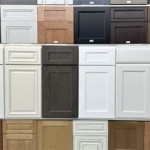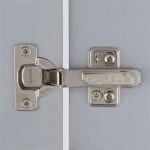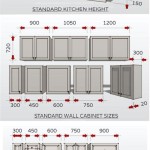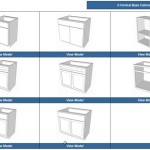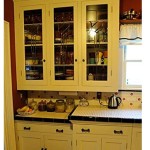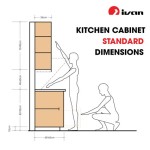How To Properly Organize Your Kitchen Cupboards
An organized kitchen is a critical component of an efficient and enjoyable home. Among the various elements contributing to kitchen organization, the proper arrangement of kitchen cupboards stands out as a particularly impactful area. Well-organized cupboards not only enhance accessibility to frequently used items but also contribute to a more aesthetically pleasing and less stressful cooking environment. This article provides a comprehensive guide on how to effectively organize kitchen cupboards, covering key steps and strategies for optimized space utilization and improved functionality.
Assessment and Decluttering
The initial stage in organizing kitchen cupboards involves a thorough assessment of their current state and a rigorous decluttering process. This step is essential to identify what items are present, determine their relevance, and eliminate unnecessary clutter. A systematic approach is recommended to ensure that nothing is overlooked.
First, remove all items from the cupboards. This allows for a complete visual inventory and the opportunity to thoroughly clean the empty space. Wipe down shelves and drawers using a suitable cleaning solution to remove dust, spills, and any accumulated grime. This creates a fresh and clean foundation for the reorganization process.
Next, categorize the removed items into distinct groups based on their function or type. Common categories include: cookware (pots, pans, baking sheets), dinnerware (plates, bowls, cups), glassware (drinking glasses, storage containers), dry goods (canned goods, pasta, rice), and small appliances (blenders, toasters, food processors). This categorization will facilitate efficient placement and retrieval during the reorganization phase.
The decluttering process involves a critical evaluation of each item. Ask the following questions to determine whether an item should be kept: Has it been used in the past year? Is it in good working condition? Is it a duplicate of another item? Does it hold sentimental value? Be honest and objective in these assessments. Items that fail these criteria should be discarded, donated, or sold. Prioritizing functionality and practicality over sentimentality is key to minimizing clutter.
Discard broken, damaged, or expired items immediately. Donate or sell items that are still usable but no longer needed. Proper disposal not only clears space but also promotes responsible resource management. Consider local charities or online marketplaces for donation or sale options.
Strategic Placement and Arrangement
Once the decluttering process is complete, the next step is to strategically place and arrange the remaining items within the cupboards. This involves considering frequency of use, weight, and accessibility to optimize functionality and convenience. Proper placement significantly reduces the time and effort required to locate and retrieve necessary items.
Items used most frequently should be placed in easily accessible locations, typically within arm's reach on the middle shelves. This minimizes the need to reach overhead or bend down to retrieve everyday essentials. Examples of frequently used items include plates, bowls, glasses, and everyday cookware.
Heavier items, such as large pots and pans, should be placed on lower shelves to prevent strain and reduce the risk of injury when lifting and retrieving them. This also provides a more stable base and reduces the likelihood of items toppling over.
Lighter items, such as cups, glasses, and infrequently used kitchen gadgets, can be stored on higher shelves. Ensure that these shelves are stable and can support the weight of the items. Utilizing step stools or reaching tools can aid in accessing items on higher shelves safely.
Consider the layout of the kitchen when determining the placement of items. Place cookware near the stovetop, dinnerware near the dishwasher, and dry goods near the food preparation area. This strategic placement optimizes workflow and reduces unnecessary movement within the kitchen.
Group similar items together. Store all baking supplies in one cupboard, all cooking utensils in another, and all dry goods in a designated pantry area. This creates a logical organization system that simplifies finding specific items when needed. Labels can be used to further identify the contents of each cupboard or shelf.
Maximize vertical space by using shelf organizers or risers. These tools create additional storage levels within the cupboards, allowing for more efficient utilization of available space. They are particularly useful for storing plates, bowls, and canned goods.
Implement drawer dividers to separate utensils, cutlery, and cooking tools within drawers. This prevents items from becoming jumbled and makes it easier to locate specific items. Clear plastic or adjustable dividers are ideal for customizing drawer organization.
Utilizing Organizational Tools and Accessories
To further enhance the organization of kitchen cupboards, consider using a variety of organizational tools and accessories. These tools are designed to optimize space, improve accessibility, and maintain order within the cupboards. Selecting the right tools can significantly impact the overall efficiency of the kitchen.
Lazy Susans, or rotating turntables, are particularly useful for storing spices, condiments, and other small items that tend to get lost in the back of cupboards. They allow for easy access to all items with a simple rotation. They are also effective in corner cabinets.
Stackable containers are ideal for storing dry goods, such as flour, sugar, pasta, and rice. They help to keep food fresh and prevent spills, while also maximizing space within the cupboards. Choose containers that are clear and airtight for optimal storage.
Wire racks can be used to store pot lids, cutting boards, and baking sheets vertically, maximizing space and preventing them from cluttering shelves. Wall-mounted racks can also be used to free up cupboard space.
Door-mounted organizers provide additional storage space on the inside of cupboard doors. They are ideal for storing small items, such as spices, measuring cups, and cleaning supplies. Ensure that the organizers do not obstruct the closing of the cupboard doors.
Hanging organizers can be used to store utensils, cleaning tools, and other items that can be hung from hooks. They are particularly useful for utilizing empty space under shelves or inside cupboards.
Labels are an essential tool for maintaining organization. Label shelves, drawers, and containers with clear and concise labels to identify their contents. This makes it easier to find items and helps to ensure that they are returned to their proper place after use. Use a label maker or pre-printed labels for a professional and consistent look.
Consider using bins and baskets for storing irregularly shaped items or items that do not stack well. They can be used to group similar items together and prevent them from cluttering shelves. Wicker baskets, plastic bins, and wire baskets are all viable options.
By incorporating these organizational tools and accessories, it is possible to transform cluttered and inefficient kitchen cupboards into well-organized and functional storage spaces. Regular maintenance and adherence to the established organization system are key to maintaining long-term order and efficiency.

How To Organize Your Kitchen Cabinets Step By Project The Container

How To Organize Your Kitchen Cabinets In 3 Simple Steps Practical Perfection

60 Clever Cabinet Organization Tips To Double Your Storage 2024

How To Organize Your Kitchen Cabinets Step By Project The Container

60 Clever Cabinet Organization Tips To Double Your Storage 2024

How To Organize Your Kitchen Cabinets And Pantry Feed Me Phoebe

How To Organize Kitchen Cabinets In 9 Simple Steps Trusted Since 1922
:strip_icc()/121035540_331772381251072_3717720175166945340_n-ae336a3237ca44c6bdddd093c7d1eb97.jpg?strip=all)
21 Kitchen Cabinet Organization Ideas You Need To Try

How To Organize Your Kitchen Cabinets And Drawers She Gave It A Go

How To Organize Your Kitchen Cabinets One At A Time
Related Posts


